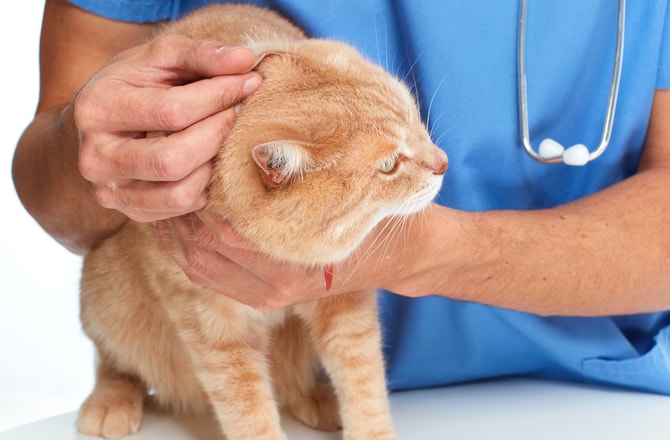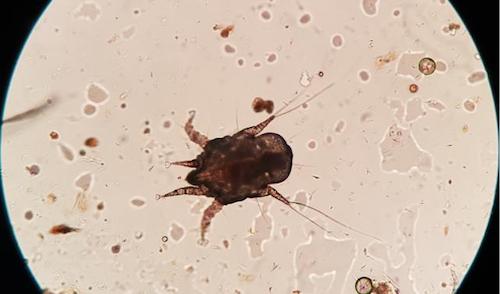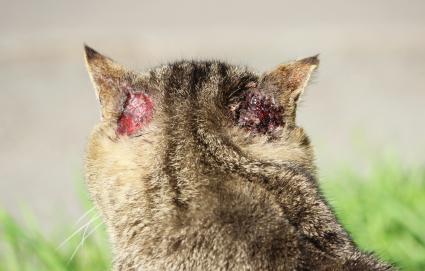Yes, we are here to talk about ear problems in our feline friends. Problems might range from simple to complex where you might notice your kitty pawing at the ears, shaking her head, her ear might be sensitive to touch or you might notice a large amount of cream-colored, orange, dark brown, or black wax in and around ears.
There could also be some severe symptoms like hearing loss and loss of balance. So what are the most common ear issues cats suffer from?
The 11 Common Cat Ear Problems

The most common ear problems as found in cats are ear infections, ear mites, and ear tumors. But there are few more problems prevalent among cats like polyps, ear wax build-up, foreign body in ear, dermatitis, ear bleeding and allergies
Particularly, most of the ear problems cause a discharge from your cat’s ear that tends to have a foul odor. The color of the discharge could look dark and grainy like grounded coffee. You might also notice discharge of cream or orange color. Veterinary advice is suggested in any case and in all of the conditions discussed below.
1) Ear Mites

To find out if your cat has ear mites, take a sample of ear wax with the help of a cotton ball (Do not use cotton swabs). You will notice a discharge that looks like ground coffee and has a bad odor. Ear mites are very tiny white bugs, which can be seen with the help of a magnifier.
A veterinarian doctor will confirm your diagnosis by looking at a sample of the same under a microscope. The doctor will prescribe your cat an ear mite treatment, which you must follow properly otherwise problems could become severe.
Also Read: The Best Cat Ear Cleaners
2) Mange

To get appropriate treatment, a veterinarian examination is a must, who will check your cat under a microscope to identify the type of mite that is present. Then the doctor might prescribe insecticides to kill the mange mites.
3) Ear Infections
Ear infection, caused by yeast or bacterias is the most common issue of all the ear problems. Symptoms of an inner ear infection may include redness in ear, head shaking, rubbing the ears, tilting head, decreased appetite, laziness, difference in pupil sizes, abnormal eye movements, difficulty walking or hearing loss.
Inner ear infections are determined by a physical examination and sometimes require x-rays, CT scans or MRIs of the affected areas. A long term treatment with antibiotics and topical medications is provided. In severe but rare cases your cat might need to get a surgery done.
4) Ear Tumor
Ear tumors in cats are formed of blood clots mostly caused by over-scratching the ear. It might affect the earwax glands, bones, tissues, muscles or middle layers of the cat’s ear.
Symptoms of ear tumors in cats are itching and pain of the ears leading to ear discharge or sometimes inner ear bleeding. Signs that a cat parent should notice for an ear tumor are deafness due to swelling, frequent ear scratching, head shaking, a foul odor coming from the ear discharge and blood or pus inside ears. Your cat might also face problems like imbalance while walking and head tilting.
5) Ear Wax Build up
Your cat’s ear wax, also called cerumen, is naturally brown in color which might also look like dried blood clot to you. Usually, a cat produces a little ear wax, but those having an inflammation from allergies might produce more ear wax than normal.
Other causes of ear wax build up could be ear infections and sadly, the wax buildup can cause other infections resulting in two problems to deal with. The wax will not just smell bad but will also cause too much irritation to your little furry friend.
6) Foreign Body in the Ear
Particularly those cats that usually go outdoor and often play in garden and lawns, get the grass awns and other foreign bodies lodged in their ears. If your cat has a foreign body lodged in her ear then you might notice her shaking head and rubbing paws on ear frequently.
You can easily examine her ears and if you find something lodged in then try to pull it out gently. If it does not come out easily, then do no forcefully remove the obstacle, rather take your cat to the veterinarian. The doctor can safely remove the foreign body and would give you a medication in case of any damage caused to the ears.
7) Ear Edge Dermatitis
Some cats have a reaction of certain ointments, as a result, the inner hairless part of the ear gets affected. This inflammation which is called dermatitis can develop within a week after starting the use of a topical medication or sometimes by a mosquito bite too.
The symptoms that are noticed in a dermatitis are swelling, sores, bumps and redness on the edge of your cat’s ear. Veterinarians generally treat it by stopping all ointments or topical medications. Your vet might switch to another ointment or prescribe medicines to cure the condition.
8) Ear Allergies
Cats with food allergies, often develop itchiness around their head and ears. If no proper cause is found for the itching then there are chances your cat is allergic to certain types of food.
To treat this condition you have to try some best hypoallergenic cat foods that are only available through veterinarians.
9) Ear Polyps
Nasopharyngeal polyps grow within a cat’s middle ear or Eustachian tube. These polyps are benign and they might cause to develop middle ear infections in your cat. You may notice symptoms like loud breathing and nasal discharge.
To diagnose a polyp in your kitty’s ear, a veterinarian would anesthetize your cat. The vet doctor will thoroughly examine the ears and the mouth, take x-rays and perform a surgery to remove to the polyp.
10) Ear Bleeding
Reasons for cat ear bleeding are many which include:
- Wounds caused by animals bites
- Hematoma
- Solar Dermatitis
- Sarcoptic or Notoedric Mange
- Autumn-harvest mite
- Parasitic Otitis
- Bacterial or Yeast infections
- Ear Mites
- Polyp
All conditions need serious medical attention.
11) Folded Ears
Folded ear tips in cats, usually are the result of long-term use of anti-inflammatory steroid drugs, usually in the form of daily eye or ear drops. Whereas, a long term exposure to the sun can also cause damage to the ear muscles. Ear folding is often a permanent condition. Other reasons could be hereditary or Immune System Disorder.
Prevent Cat Ear Problems
To maintain your cat’s ear health, regularly check her ears for any signs of wax buildup, inflammation or odor. If you notice a change in your cat’s behavior or find any of the symptoms then immediately visit a veterinarian doctor.
Cat’s ears are very fragile. To avoid any damage to her eardrums and to stop the infection to spread, you should keep checking your cat for ear discharge. Never leave a condition untreated until it becomes chronic.

